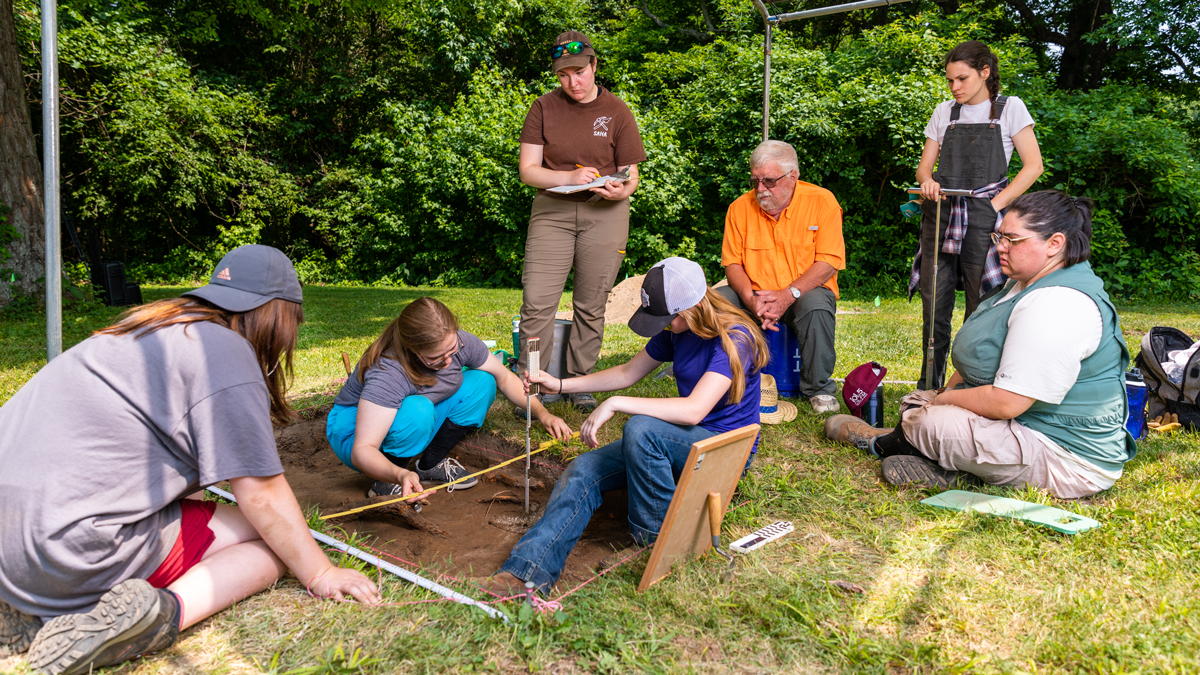SIU’s archaeology summer field school unearths Fort Kaskaskia’s past
June 23, 2023
You can read about how to use a trowel and how to measure and document a site. But until you are in the dirt, with stiff muscles and the sweat running down your back, until you have the excitement of uncovering some real history, you don’t really know archaeology. That’s what students in Southern Illinois University Carbondale’s Archaeology Field School say about their experience this summer at Fort Kaskaskia.
“I really wanted the archaeology field experience,” said Jessica Rice, a senior in anthropology at SIU. “This is where you really get to learn the different techniques. You can read about it, but it makes sense when you are actually doing it.”
Archaeology students from five universities, including SIU Carbondale, and six high school students have spent the past several weeks at the Fort Kaskaskia State Historic Site in Randolph County excavating French and American forts once visited by the Lewis and Clark Expedition. Research work has been underway since May 22 and will continue through June 30. This year’s goal is to find the fourth wall of the American fort, which is separate from the French structure. Digging began June 16, with the team looking for a trench used to support a stockade for the fourth wall.
Advertisement
Historians long believed that Fort Kaskaskia served as a fort for both 1750s French and early 1800s American troops. The most prominent event in the fort’s history was a visit by the Lewis and Clark Expedition in 1803 to recruit 12 soldiers for the group to explore the American West.
But in 2017, after two seasons of work, the team of SIU archaeologists and students concluded that, in fact, two separate forts — one French and one American — were constructed near each other — and separated in time by 45 years.
Mark Wagner, Center for Archaeological Investigations director and professor in anthropology, said the American fort was active 1803-1806 and passed almost immediately from memory when it was no longer needed. One reason is that Gen. John Edgar owned the land and leased it for small, 120-by-120-foot fort, so he owned the fort once it was no longer in military use. Wagner said archaeological evidence shows that the stockade was pulled from the ground. What appears to have happened is that Edgar sold the lumber from the fort – because it literally disappears in 1806.
“It just drops out of memory,” Wagner said.
Numerous artifacts found
“There are a lot of artifacts here. We’ve found plenty of uniform buttons in the past and bullets. This year, we found the first spent, or fired, bullet,” said Wagner, who guessed the bullet was inside an animal killed for food. Researchers have found an area with a lot of animal bones, indicating human consumption.
They have also found ceramics, including decorated pieces. At that time, only officers used ceramics and porcelain; enlisted men used wooden bowls and tin cups. In the military, officers maintained their class distinction from the enlisted men and needed nice dishes they invited each over for tea or dinner.
Advertisement*
Paolo Vitor Mendes Da Cunha, a master’s student, came to SIU from Rio de Janeiro to study forensic anthropology.
“SIU has a good program, better than what I could get in Brazil – so I wanted to come here,” he said. “I’m in the field school because I want the practical experience. This is a really cool site, and I’m learning a lot of history while working on it.”
Draws far-reaching interest
Nine SIU Carbondale students are participating this year in the field school, which draws students from throughout the United States. Five students from four other universities are attending this year, along with six students from local high schools, including Carbondale Community High School, Gibault Catholic High School in Waterloo, and Waterloo High School.
Elseah Congiardo of Chester, who attends Gibault Catholic High School, said this is her second year with the field school and has enjoyed it both times.
“It’s been a great experience. Today is our last day here, and I’m kind of sad about that,” she said.
Delia Wagner, of Carbondale, a student at Carbondale Community High School, wants to be a paleontologist, so when she did an online search for summer camps and found this one, she knew it was for her. She’s loving finding the animal bones.
Molly Cornett, who attends Western Kentucky University, is attending because she needs a field school or field experience to graduate. She and Rice, from SIU, talked about finding glass at another site and hearing what it might be. It didn’t make sense to them until they saw an example at Fort de Chartres, another French fort near Prairie du Rocher. The practical experience they are gaining is just not the same as in the classroom.
“Finding artifacts – that’s been so exciting,” Rice said. “And it’s been great to hear Dr. Wagner talk about what we are finding, and to give us some perspective about the people and the time. It’s made it more real.”
Cornett noted the work has other benefits.
”I thought dirt was always just dirt, pretty much all the same,” she said. “Now that I’ve pushed dirt through the screen so many times, I have strong opinions on what is good dirt.”
(Andrea Hahn, University Communications and Marketing, contributed to this story)
Advertisement


